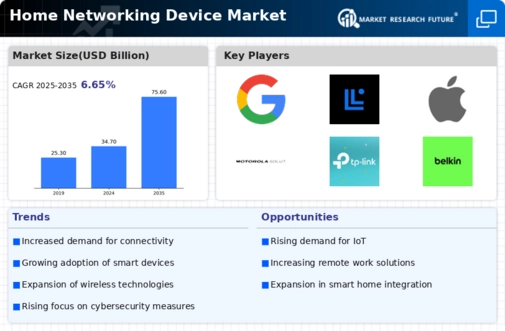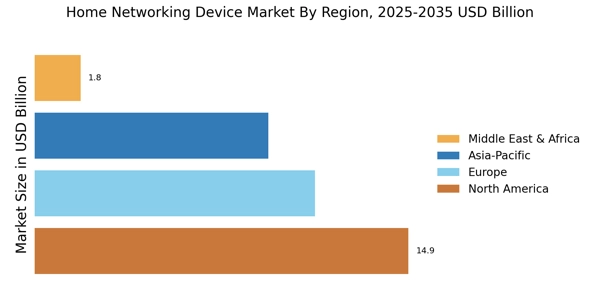Growing Focus on Cybersecurity
The heightened awareness of cybersecurity threats is a crucial driver for the Home Networking Device Market. As more devices connect to home networks, the potential for cyberattacks increases, prompting consumers to seek devices with enhanced security features. Recent statistics reveal that a significant percentage of households have experienced some form of cyber threat, leading to a demand for networking devices that offer robust security protocols. Manufacturers are responding by integrating advanced security measures, such as encryption and intrusion detection systems, into their products. This focus on cybersecurity not only protects consumers but also enhances the overall value proposition of networking devices. As a result, the Home Networking Device Market is likely to see continued growth as security becomes a paramount concern for consumers.
Rising Demand for High-Speed Internet
The increasing demand for high-speed internet connectivity is a primary driver of the Home Networking Device Market. As households and businesses alike seek faster and more reliable internet connections, the need for advanced networking devices has surged. According to recent data, the number of broadband subscriptions has seen a steady rise, with millions of new users joining each year. This trend is further fueled by the proliferation of streaming services, online gaming, and remote work, all of which require robust internet infrastructure. Consequently, manufacturers are innovating to meet this demand, leading to a diverse range of products designed to enhance connectivity and performance. The Home Networking Device Market is thus positioned to benefit from this growing consumer expectation for speed and reliability.
Increased Adoption of Smart Home Devices
The proliferation of smart home devices is significantly influencing the Home Networking Device Market. As consumers increasingly integrate smart technologies into their homes, the demand for networking devices that can support these innovations has escalated. Data indicates that the number of smart home devices is projected to reach billions in the coming years, necessitating advanced networking solutions to ensure seamless connectivity. This trend is not only about convenience but also about enhancing security and energy efficiency within homes. Networking devices must now accommodate a multitude of connected devices, which drives innovation and competition among manufacturers. The Home Networking Device Market is thus experiencing a transformation, as companies strive to create products that can effectively manage and optimize smart home ecosystems.
Shift Towards Wireless Networking Solutions
The shift towards wireless networking solutions is a significant driver of the Home Networking Device Market. As consumers increasingly prefer the convenience and flexibility of wireless connectivity, manufacturers are focusing on developing advanced wireless technologies. Recent data indicates that the demand for wireless routers and access points has surged, as users seek to eliminate the clutter of cables and enhance mobility within their homes. This trend is further supported by advancements in wireless standards, such as Wi-Fi 6, which offer improved speed and capacity. Consequently, the Home Networking Device Market is witnessing a transformation, with a growing emphasis on wireless solutions that cater to the evolving needs of consumers. This shift not only enhances user experience but also drives competition among manufacturers to deliver cutting-edge wireless networking devices.
Expansion of Internet of Things (IoT) Applications
The expansion of Internet of Things (IoT) applications is driving innovation within the Home Networking Device Market. As IoT technology becomes more prevalent, the need for networking devices that can support a vast array of connected devices is increasing. Data suggests that the number of IoT devices is expected to grow exponentially, creating a demand for networking solutions that can handle this influx. This trend is particularly relevant in sectors such as home automation, healthcare, and energy management, where connectivity is essential for functionality. Manufacturers are thus compelled to develop devices that not only provide connectivity but also ensure interoperability among various IoT applications. The Home Networking Device Market is therefore positioned to capitalize on this trend, as consumers seek reliable solutions to manage their interconnected environments.


















Leave a Comment